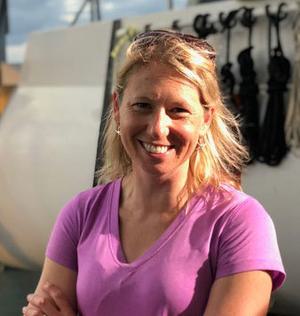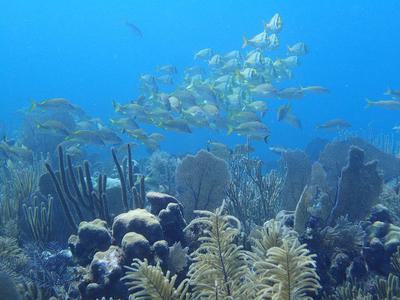The world’s coral reefs are in increasingly dire shape as pollution, coastal development, overfishing, and — perhaps most ominously — bleaching from rising ocean temperatures exact a mounting toll. But relatively intact and healthy coral reefs still exist, and among the best of them is the Gardens of the Queen National Park — Jardines de la Reina — off the southern coast of Cuba.
Protected for decades by a lack of coastal development in this communist state, the Gardens of the Queen has not been as widely studied as some renowned coral reef systems. But last month, a joint U.S.-Cuban scientific expedition, co-led by marine microbial ecologist Amy Apprill of the Woods Hole Oceanographic Institution, carried out an exhaustive 23-day research project in the 840-square-mile Gardens of the Queen park — a trip that had been planned before President Trump’s revised U.S. policy toward Cuba.
In an interview with Yale Environment 360, Apprill describes the beauty and diversity of this reef ecosystem, explains how the expedition sought to shed light on the “unseen life” of the microbial systems that sustain corals, and talks about the challenges of conducting a joint scientific inquiry with the Cubans as Trump seeks to roll back recent improvements in relations between the U.S. and Cuba. “There was a lot of hope before,” says Apprill. “There was a lot of talk about Cuba becoming more open to the U.S. That is gone. Now, the U.S. is seen as this giant power that’s not going to work with them.”
Yale Environment 360: Before we get to the science of the expedition, describe the visceral experience of diving on this really gorgeous reef.
Amy Apprill: One of the things that I notice immediately when I’m down on the more highly protected Cuban reefs is how active they are. That’s due to just the abundance of fish that are moving throughout the reef. I’m more of a coral scientist, so I tend to focus on the corals, but when I’m on these Cuban reefs, I can’t [focus] because there are just so many distractions. There’s so much life moving around. We saw abundant large fish, including parrotfish, grouper, and sharks, which I do not typically find in other parts of the Caribbean.
e360: What is the condition of the corals themselves?
Apprill: The corals tend to be larger, which means they’re longer lived. They tend to be healthier looking and they tend to be more diverse compared to other Caribbean reef ecosystems. There were elkhorn and staghorn corals, which are extinct from many Caribbean reefs, as well as larger-sized mounding corals, such as the star corals. And we saw minimal coral bleaching — no reefs appeared to have been recently impacted by bleaching, in contrast to many of the Pacific reefs.
e360: What was the purpose of the expedition?
Apprill: Our purpose was to understand the biodiversity of the Cuban coral reefs in relation to their level of protection. Cuba has a really highly protected area in the Gardens of the Queen. On the outskirts [of the marine protected area], the reefs are still legally protected, but there’s no enforcement, so there’s still illegal fishing. We also worked in areas on the outskirts that are open to some fishing. We worked throughout this gradient of protection, and our goal was to understand how biodiversity relates to protection of the reef.
“One of the unique things we were doing with this cruise was looking at some of the unseen diversity on the reefs.”
One of the unique things we were doing with this cruise was looking at some of the unseen diversity on the reefs. Traditionally, divers go down on a reef and they collect information about the organisms they can see — the fish, the corals, other invertebrates, and that’s about it. It’s a very limited view of a reef because a reef has so much more life that we can’t see. So, what we were doing is collecting water samples to look at microbial communities — the microbiome of the reef water. We were also taking samples to look at the diversity of chemicals in the reef. Because there’s so much life there, we were hypothesizing that the chemical diversity was also quite high in this environment. We were also putting recorders out on the reefs to measure the diversity of sounds produced by the fish, as well as various invertebrates. All those things go into this unseen life category.
e360: I know you’re just recently back and haven’t analyzed all the data, but any conclusions that you can share?
Apprill: With the observations that we made between the really protected areas and the less protected areas, we definitely saw more macro-scale biodiversity in the more protected areas. That diminished as you went away from the protected areas. You didn’t see as many fish. You didn’t see the large corals. That I can say even without crunching any data.
e360: Tell me more about your research into the possible symbiotic relationships that various microbes may have with coral.
Apprill: Every life form really has its own microbiome. Corals have a really established microbial association with algae, which are the plant cells that give corals their coloration, but also with bacteria and archaea [single-celled microorganisms]. Some of the work that I’ve done has helped us understand the specificity of associations between corals and bacteria and archaea. I’m really interested in how these cells are interacting with the coral and if in fact they are providing benefits to the coral, such as production of antibiotics or helping them cycle other nutrients or organic matter.
Marine life is thriving in Cuba's Gardens of the Queen National Park, where yellowtail snappers swim amid boulder star coral, gorgonians, and seafans. Amy Apprill/WHOI
e360: Antibiotics for corals? That’s pretty wild.
Apprill: It is pretty wild, but when you think about it, one of the limiting factors of a reef is a place to live, a substrate, something to colonize. You look at a coral and it doesn’t have any life growing on it, so they’re really good at keeping things off of them. So, we think they have a variety of strategies, including antibiotics produced by their associate bacteria.
e360: Where’s this research going in terms of perhaps mitigating the effects of climate change or other stresses that corals are under?
Apprill: We’re just really at the infancy of understanding these relationships. Corals have one of the most diverse microbiomes of any animal that I’ve seen, which I think speaks a lot to potentially the pressures that they’re under. I think there’s a lot of potential here for the microbiome to step up and to provide services to the coral under change. At the same time, we’re seeing levels of change we’ve never seen before. We still need a lot of experimental data to be better informed about how the microbes might be helping.
We’ve been thinking a lot about how corals recruit their microbes. The majority of them get them from microbes in the seawater. We’ve identified some unique communities of microbes living right around the coral. We think there’s this new ecosystem of microbial life that is interacting in a different way. It’s really exciting to think about how microbes are interacting with corals.
e360: You mentioned recording the reef soundscape. Is that a common technique?
Apprill: It’s kind of a new and emerging technique. I would say there are a couple handfuls of labs around the world doing this kind of analysis. What’s neat about it is that you can listen to reefs when you’re not there. You can put these recorders down on the reefs and have them record every few minutes for hours, for days even.
One of the most abundant reef noises is snapping shrimp. As many reefs as I’ve dove on in my life, I don’t think I’ve ever seen a snapping shrimp. They hide in these reef crevices and sponges, and other nooks and crannies of the reefs, but they’re the major sound producer on the reef. Just understanding their noise dynamics and what are some of the components of their sounds, their chorus — those are some of the questions that our scientists are looking at.
The sounds of Cuba's coral reefs. (Credit: Dr. Ashlee Lillis, WHOI)
e360: You co-led a joint Cuban-U.S. expedition to this area and were on the first non-Cuban vessel to be granted permission to conduct research there. How did you manage that?
Apprill: There was a lot of planning. There were many moments when I didn’t think the cruise was actually going to be able to happen. We’ve been working on this for about a year and a half. Part of that was just getting the permissions or getting the vessel. But working with the Cubans was something. We had people going down to talk directly with the Cubans. We ended up associating with eight different components of their science governmental organizations. It was very involved.
e360: You can’t use federal funds to do research in Cuba. How was this expedition funded?
Apprill: This was funded by the Dalio Explore Fund and the Dalio Ocean Initiative.
e360: What strengths did the Cuban scientists who were on board bring to the table, and what were the strengths of the U.S. team?
Apprill: The Cuban scientists had knowledge and expertise in working in the protected area, and bringing that knowledge was really key and helped us understand more about the history of the protection and where exactly the illegal fishing happens. They also have a lot of expertise about Cuban reefs in general. We had scientists who were gathering data about the coral diversity and coral health. The U.S. scientists really brought new techniques and technology and the ability for us to start looking at this unseen component of the reef.
Cuban scientists “want to work with us, but they see our country as putting in these new rules and restrictions.”
e360: You have an interesting perspective when it comes to working in Cuba. You went there initially in 2014 when President Obama was opening up our relations with the country. When you were there this time around, President Trump announced further restrictions on U.S. citizens traveling to Cuba. Compare how those two different political temperatures affected your time in the country or perhaps even your research.
Apprill: I think it’s changed the mentality of working with the Cubans a bit. They seem very scared of making any kind of mistake in working with us or the U.S. government. They want to work with us, but they see our country as putting in these new rules and restrictions, and they have to do everything very carefully so there are not more restrictions. For our research program, too, we were hoping to have some exchanges where Cuban scientists come over here. I haven’t even started navigating that, to understand how that has been impacted, but I suspect it may take longer to get visas. There was a lot of hope before. There was a lot of talk about Cuba becoming more open to the U.S. and seeing increases in tourism. That is gone. Now, the U.S. is seen as this giant power that’s not going to work with them.
e360: Given that, what are your realistic goals in terms of building on this expedition?
Apprill: We had a scientific conference at the end of the cruise, in Havana, and the government officials were so enthusiastic about our partnership. We actually have a technology transfer agreement in place, which is something really novel. We have a level of trust that just wasn’t there before. We have a really good working relationship. Given the hardships of trying to raise money and figure out logistics working with them, they’re actually really open to it right now. I do feel like I have a bit of a weight on my shoulders in trying to continue what I’ve started.




